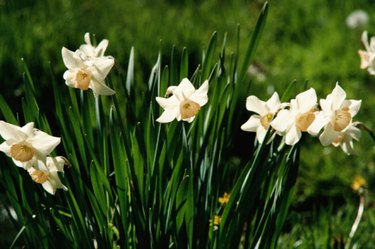
The splendor of the display of daffodil flowers (Narcissus spp.) wanes by mid to late spring, leaving only dried petals, seed heads and narrow green leaves. While the foliage may look untidy and unattractive, it serves a crucial and necessary purpose -- making food for storage in the healthy underground bulb. Resist the urge to cut off any daffodil leaves that are still green. Removing the leaves or tying them back, limiting their exposure to sunlight, only leads to less vigorous and weaker bulbs that don't produce as nice a flowering show next year.
Time Frame
Video of the Day
Wait until daffodil foliage naturally yellows and flops over to the ground before considering cutting it back. Regardless of the appearance of other seasonal flowers in the planting bed, do not cut back daffodil leaves, or braid them to make them look tidier. Depending on your climate, especially temperatures, the foliage continues to photosynthesize light until late May in the southern U.S. or late June or early July closer to the Canadian border. If possible, wait until at least one-half of an individual leaf has turned yellow or brown before cutting it off at ground level.
Video of the Day
Effects of Premature Cutting
While a garden novice may want to cut back the foliage of all spring flowering bulbs in her garden, it's a bad practice. Ultimately, the loss of food-making leaves leads to the underground bulbs becoming scrawny and malnourished. Weak bulbs cannot make daughter bulbs to increase the plant clump and shriveled bulbs don't survive the winter well. Some bulbs may survive even if you cut off green leaves, but next spring the bulb won't yield as large of a blossom, or none at all.
Cutting the Foliage
If you choose to cut off daffodil foliage when there's no more than one-half green coloration, wear gloves. The sap in the leaves is slimy and the toxins may cause dermatitis in sensitive people. You can either cut the leaves back fully to the ground or trim off the top half to two-thirds to remove the yellow or tan tissues, but leave the lower green blades. Cutting off the upper yellowed halves of the foliage retains the food-making green portion while also tidying the look of the flower bed. Allow the lower leaf stubs to naturally yellow and decompose without another cutting project in early summer.
Reducing Visual Impact
The look of withering, yellow daffodil foliage certainly isn't attractive, but it's a necessary evil in the garden. Mississippi State University Extension horticulturalist Gary Bachman suggests diminishing the look of the foliage through smart flower planting. Under-plant daffodils with other spring flowering plants like pansies, snapdragons or emerging growth of summer-blooming perennials. Summer annuals may also grow up as the daffodils slowly wither. These plants partially mask the daffodil leaves while still letting sunlight reach them. Do not plant daffodils in lawns you regularly mow. Naturalized drifts of daffodils need to be planted in a non-mowed meadow field or left in the lawn until the daffodils wither away before being mowed.